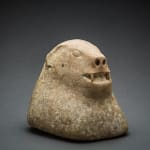Central Asian Head of an Animal, 1500 BCE - 900 BCE
Stone
14.6 x 12.1 x 13.3 cm
5 3/4 x 4 3/4 x 5 1/4 in
5 3/4 x 4 3/4 x 5 1/4 in
LO.1401
Further images
The profile of the animal bears strong resemblance to a rodent. The lateral and vertical perspectives of the skull show a notable massivity from the jaw to the apex of...
The profile of the animal bears strong resemblance to a rodent. The lateral and vertical perspectives of the skull show a notable massivity from the jaw to the apex of the head, and a wide yet tapering vertical profile from the small, semi-round ears to the end of the snout. The nose is simply yet effectively rendered with two round-oval nostrils and a narrow septum, overhanging an open mouth with a curled tongue. The mouth is marked at the corners with long, dagger-like canines; no other teeth are present. The eyes are simple and naturalistic and are not schematic nor stylised in the manner of Horus or Anubis. The surface of the stone is very carefully worked, and the marks of the tools are still visible over the head. Interestingly, the head fades away to rougher, less well-defined stone that acts as a pedestal for the finer carving above. The base, likewise, is unfinished and rough, with the marks of rough hewing with a large tool clearly visible over the whole surface.
This piece bears a strong resemblance to a New Kingdom Egyptian canopic jar lid. A tradition which carried over from the Old Kingdom into the New Kingdom of Egypt was that of mummification, in which the body was preserved by a series of chemical reactions, and the internal organs were removed and placed inside containers dubbed "canopic jars". These jars - and especially their lids - were often highly ornate, and represented various characters from Egyptian mythology that were involved in the reincarnation process and the afterlife. However, there is no specific mention of rats or indeed any other form of rodent in any of the god lists for ancient Egypt in any period, and there is no cultic or religious potency ascribed to them. As the canopic jars are designed to protect and defend the internal organs in the manner characterised by the deities portrayed thereupon (namely the four sons of Horus: Duamutef, the jackal-headed defender of the stomach; Qebehsenuef, the falcon-headed defender of the intestines; Hapi, the baboon-headed defender of the lungs and Imseti, the human-headed defender of the liver), it is unlikely that the embalmers would have decided to portray what the Egyptians viewed as vermin in any of their places. Further research also suggested that the stone used in the current case was unlike the majority of elite canopic jars, that are typically made from soft, white stone such as alabaster, rather than this extremely hard and heavy stone.
Following stylistic guidelines, it would appear that this piece is in fact Central Asian, which is in line with the form, the finish and elementary assessments of the petrology. The precise location is uncertain, but the area between Northern Iran and Western Mongolia seems likely. The piece must have been a cultic object, presumably with religious significance to the population in question, and with a function that is currently unclear. The rough base suggests either that the piece was unfinished, or, more likely, that the rough base reflects some aspect of its usage. Whatever the reason, this is a unique and important masterwork.
This piece bears a strong resemblance to a New Kingdom Egyptian canopic jar lid. A tradition which carried over from the Old Kingdom into the New Kingdom of Egypt was that of mummification, in which the body was preserved by a series of chemical reactions, and the internal organs were removed and placed inside containers dubbed "canopic jars". These jars - and especially their lids - were often highly ornate, and represented various characters from Egyptian mythology that were involved in the reincarnation process and the afterlife. However, there is no specific mention of rats or indeed any other form of rodent in any of the god lists for ancient Egypt in any period, and there is no cultic or religious potency ascribed to them. As the canopic jars are designed to protect and defend the internal organs in the manner characterised by the deities portrayed thereupon (namely the four sons of Horus: Duamutef, the jackal-headed defender of the stomach; Qebehsenuef, the falcon-headed defender of the intestines; Hapi, the baboon-headed defender of the lungs and Imseti, the human-headed defender of the liver), it is unlikely that the embalmers would have decided to portray what the Egyptians viewed as vermin in any of their places. Further research also suggested that the stone used in the current case was unlike the majority of elite canopic jars, that are typically made from soft, white stone such as alabaster, rather than this extremely hard and heavy stone.
Following stylistic guidelines, it would appear that this piece is in fact Central Asian, which is in line with the form, the finish and elementary assessments of the petrology. The precise location is uncertain, but the area between Northern Iran and Western Mongolia seems likely. The piece must have been a cultic object, presumably with religious significance to the population in question, and with a function that is currently unclear. The rough base suggests either that the piece was unfinished, or, more likely, that the rough base reflects some aspect of its usage. Whatever the reason, this is a unique and important masterwork.







